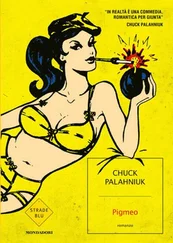Chuck Palahniuk - Fugatives & Refugees
Здесь есть возможность читать онлайн «Chuck Palahniuk - Fugatives & Refugees» весь текст электронной книги совершенно бесплатно (целиком полную версию без сокращений). В некоторых случаях можно слушать аудио, скачать через торрент в формате fb2 и присутствует краткое содержание. Жанр: Современная проза, на английском языке. Описание произведения, (предисловие) а так же отзывы посетителей доступны на портале библиотеки ЛибКат.
- Название:Fugatives & Refugees
- Автор:
- Жанр:
- Год:неизвестен
- ISBN:нет данных
- Рейтинг книги:5 / 5. Голосов: 1
-
Избранное:Добавить в избранное
- Отзывы:
-
Ваша оценка:
- 100
- 1
- 2
- 3
- 4
- 5
Fugatives & Refugees: краткое содержание, описание и аннотация
Предлагаем к чтению аннотацию, описание, краткое содержание или предисловие (зависит от того, что написал сам автор книги «Fugatives & Refugees»). Если вы не нашли необходимую информацию о книге — напишите в комментариях, мы постараемся отыскать её.
Fugatives & Refugees — читать онлайн бесплатно полную книгу (весь текст) целиком
Ниже представлен текст книги, разбитый по страницам. Система сохранения места последней прочитанной страницы, позволяет с удобством читать онлайн бесплатно книгу «Fugatives & Refugees», без необходимости каждый раз заново искать на чём Вы остановились. Поставьте закладку, и сможете в любой момент перейти на страницу, на которой закончили чтение.
Интервал:
Закладка:
This is the world-famous Self-Cleaning House, designed and built by Frances Gabe, an artist, an inventor, and a great storyteller. Here in her house the walls are concrete block, with entire walls made of special blocks mortared sideways so the hollow cores form little windows. Sealed on both sides with Plexiglas, the windows hold small knickknacks you never have to dust.
Some open blocks in the wall are glazed with amber glass, giving the rooms a golden honeycomb light. A beehive feeling. "The light ought to go from one side of the house to the other," Frances says, "clear through."
One door is a solid slab of casting resin with slices of bark sealed inside. Frances was so in love with the red-purple color of the local poison oak, she tried to mix paints to match it. She never could, so she tried to save it by casting it inside resin. To her disappointment, the resin turned the bark black.
To clean the house, you just turn on the water to a spinning spray head in the center of each room's ceiling. You add soap through a stint in the plumbing. The wash and rinse water run down the sloped floor and out through the fireplace. You turn on the heat and blower to dry everything. In the kitchen, open work shelves allow all the water to drain through to the floor. A hatch in the wall channels trash down a chute to the garbage can. Clothes are washed and dried as they hang on hangers hooked to a chain that pulls them through each process in a three-part cabinet. The first part is a washing closet, the middle third is a dryer, the last third is the storage closet where the clothes wait, ready to wear.
Frances chose concrete block to dissuade termites, carpenter ants, and gophers. "They're all looking for living quarters and they'd be very happy to share mine with me." Despite the concrete, a chipmunk keeps getting in to eat her bananas.
The walls are covered with paintings and pencil sketches Frances has done, all of them waterproofed to protect them from the overhead soap and water sprays. The floors are sloped a half inch for each ten running feet. The only item that's not waterproof is a rug on the floor that has to be rolled and set aside when the room is washed. The house has withstood two earthquakes, three floods, and the hurricane of the 1962 Columbus Day storm.
Framed on one wall is a U.S. government patent for the Self-Cleaning House. "It was the only patent of its kind the government ever issued," Frances says. "Instead of a single sheet, this is like a book." Behind the top sheet there are twenty-five different patents for different aspects of the house.
Today she wears a bright red sweater and slacks, and black-framed glasses. Her gray hair is curly and short. She walks as little as possible, moving from chair to chair, to finally a wheelchair that lets her move around her studio, from her drafting board to her desk to a half dozen other projects. Molly, her Great Dane, is always beside her.
Born Frances Grace Arnholtz in 1915, she went to eighteen different grade schools, moving around with her father, a building contractor. "I was born a most unusual person so I had a heck of a time in school," she says. "Everything moved much too slowly. My last day, I stood up in class and screamed at my teacher, 'You told us that last week!'"
She adds, "I just wanted to get an education and get out of there!"
Frances graduated in 1931, at the age of sixteen. At seventeen, she married Herbert Grant Bateson. "He was six-foot-two and I was five-foot-two, and we got kidded a lot," she says. "He was a building contractor, and I was my husbands boss."
After their divorce she changed her last name to Gabe, a name she invented using the first letters of her middle name (Grace) her maiden name (Arnholtz) and her married name (Bateson). She explains, "I added the E to keep it from being 'Gab.'"
The hearth of her bedroom fireplace is paved with hand-cast tiles, printed with her initials, F.G.A.B.
In the 1940s she designed her self-cleaning house and toured the country with a model. It's just returned from a two-year loan to the Women's Museum in Dallas, Texas. "Now," she says, "people are yelling for floor plans for the model."
To see her self-cleaning house, drive south on Interstate 5 through Portland to the Newberg exit. Then take Highway 99W south through Tigard to the town of Newberg. At the far side of the small downtown area, look for the traffic light at Main Street and turn left. Follow Main through another light and a stop sign, where it becomes Dayton Avenue. Follow Dayton Avenue until it crosses a bridge over a ravine. Take the first right turn, onto a gravel road, and veer to the right. The Self-Cleaning House is the last house on this road. But—and I cannot stress this enough— call first! The number is 503-538-4946. Be polite and expect to negotiate a small fee for your tour.
Sitting in her studio, with the wide windows looking down into the canyon of Chehalem Creek, Frances Gabe works on more floor plans for her famous house. "In high school," she says, "my psychiatrist told me, 'You're many times over a genius. The world belongs to you, and don't let anyone tell you anything different.'"
2. House of Cunt
Forget the Vagina Monologues. This three-woman, two-man theater troupe has gone from parading the street in nothing but G-strings made from human-hair toupees to opening for the Oregon Ballet. Wherever you find them, they'll be pushing the envelope with their experimental comedy and music.
3. Volcano Basketball
On Portland's east side, Mount Tabor, Mount Scott, and Rocky Butte are all volcanic vents left over from the last eruptions of now dormant Mount Hood. Until the next eruption, an asphalt basketball court on Mount Tabor fills the dormant crater.
4. Adult Soapbox Derby
Every August, grown-ups race their homemade cars down the steep slopes of Mount Tabor. Cars crash. People are hurt. And someone wins. It's a blast. Look for the preliminary race around August 10, with the finals two weeks later. Or hang out with the racers at the sponsoring bar, Beulahland, 118 NE Twenty-eighth Avenue. Phone: 503-235-2794.
5. Santa Rampage
Drinking a hallucinogenic liqueur—made by soaking marijuana in rum, and called "Reindeer Fucker"—the jolly "red tide" of several hundred Santa Clauses crashes elegant holiday parties, storms through swanky restaurants, boogies in strip clubs, and generally keeps Portlands Central Precinct busy and paranoid. Most American cities have their own "Rampage," but Portlands—held the second weekend in December—is still one of the biggest and best. For more details, see "A Postcard from 1996."
6. The Emily Dickinson Sing-Along
Did you know you can sing any poem by Emily Dickinson to the tune of "The Yellow Rose of Texas"? Well, come the Belle of Amherst's birthday—December 10—join the crowd at Cafe Lena, 2239 SE Hawthorne Boulevard, to sing the collected works of Dickinson.
7. Abandoned Timberline Highway
From the lower end the old road to Timberline Lodge is almost impossible to find, according to Portland architect Bing Sheldon. The original route to the lodge, it's a curving scenic two-lane road that crosses stone bridges and skirts huckleberry fields. Bing says, "It really is an undiscovered treasure." Like the lodge, the road was built during the Depression but was obsolete and replaced by the end of World War II.
"It's still paved, and you can still drive on it," Bing says. "It's a wonderful engineering feat, built on a six percent grade." To find the old road, he says, start at the top, at Timberline Lodge. Driving down from the lodge, look for the first post of the ski lift and a road that heads off to the right, passing under the ski lift.
8. Fire Department Ride-Alongs
The Portland Fire Bureau responds to about one fire every three hours. If you can wait, you can ride along. According to a spokesman for the bureau, you must be eighteen and, yes, you can ride on the fire engine. The only thing you can't do is go into the fire. Bummer. To make your plans, call the chief at one of the fire stations.
Читать дальшеИнтервал:
Закладка:
Похожие книги на «Fugatives & Refugees»
Представляем Вашему вниманию похожие книги на «Fugatives & Refugees» списком для выбора. Мы отобрали схожую по названию и смыслу литературу в надежде предоставить читателям больше вариантов отыскать новые, интересные, ещё непрочитанные произведения.
Обсуждение, отзывы о книге «Fugatives & Refugees» и просто собственные мнения читателей. Оставьте ваши комментарии, напишите, что Вы думаете о произведении, его смысле или главных героях. Укажите что конкретно понравилось, а что нет, и почему Вы так считаете.




